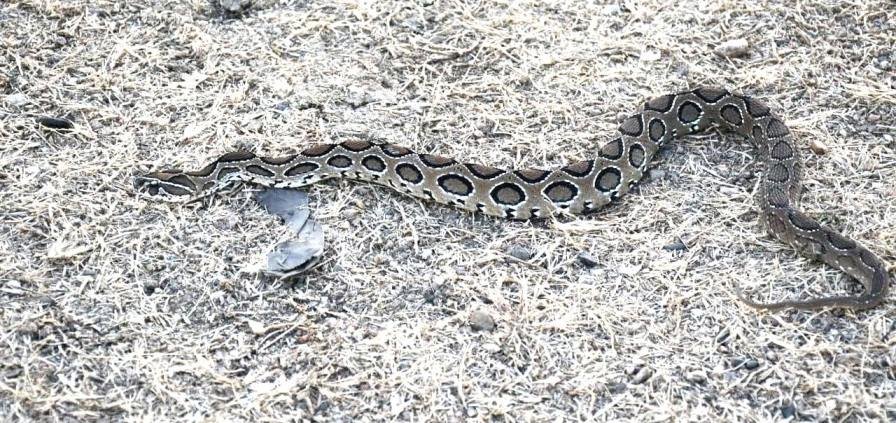Russell’s Viper (Daboia russelii) is one of the most dangerous venomous snakes in Asia and is responsible for a large number of snakebite fatalities in India. Found primarily in the Indian subcontinent, this snake is widely feared for its potent hemotoxic venom and aggressive behavior when threatened. Named after Patrick Russell, a Scottish herpetologist, this viper belongs to the family Viperidae. With a stout body, triangular head, and distinct chain-like dorsal pattern, the Russell’s Viper is both beautiful and deadly. It often resides near human settlements, increasing the likelihood of accidental encounters. Despite its lethal reputation, it plays a crucial ecological role by controlling rodent populations, which helps protect crops and reduce disease vectors. This species is often mistaken for non-venomous snakes due to its color pattern, which leads to underestimation and increased risk. Proper education and awareness can significantly reduce fatalities and improve coexistence with this misunderstood reptile.
Russells Viper Snake

Species Profile of Russell’s Viper Snake
| Attribute | Description |
|---|---|
| Snake Name | Russell’s Viper |
| Scientific Name | Daboia russelii |
| Wildlife Protection Act (WLPA) Schedule | Schedule II of Indian Wildlife Protection Act, 1972 |
| Regional Names | Indian Languages: Marathi: घोणस (Ghonas), सोन्या परड (Sonya Parad – Wardha), कांबळ्या (Kamblya – North Konkan), सूर्य कांडर (Surya Kaandar – Tal Konkan), पिरीमिटी (Pirimiti – Vidarbha), कुसडो (Kusdo – Goa), माहोळ (Mahoł – Goa), बहिर्या परड (Bahirya Parad – Chandrapur), जोगीरा (Jogira – Velha) Gujarati: તરાછ (Tarachha), ખડચિતડ (Khadchitad), કામળીઓ (Kamliyo), ઝેરી પૈડકુ (Zeri Padkoo), ઉડણેયન (Udaneyn), પડકું (Padku), પૈડકું (Paidku), ફુરસા (Fursa – sometimes also used for Saw-scaled Viper) Hindi: दबौया (Daboyya), दगाबाज सांप (Dagabaaz Saanp), घोणस (Ghonas), घो (Gho), घोड़ा (Ghoda) Malayalam: അണലി (Anali), രക്ത അണലി (Raktha Anali), വട്ടക്കൂറ (Vattakkoora), ചേനത്തണ്ടൻ (Chenathandan), മഞ്ചട്ടി (Manchatti) Tamil: கண்ணாடி விரியன் (Kannadi Viriyan) – “Glass Viper” or “Spectacled Viper” Kannada: ಕೊಳಕ ಮಂಡಲ (Kolaka Mandala), ಕಲ್ಲು ಹಾವು (Kallu Havu – sometimes also used for Saw-scaled Viper) Telugu: రక్త పింజರಿ (Raktha Pinjari), రక్త పినగ (Raktha Pinaga) Bengali: চন্দ্রবোড়া (Chandraboda), উলু বোড়া (Ulu Boda) Assamese: চন্দনচূড় (Chandanchoor), ঘোঁৰা সাপ (Ghora Xap) Oriya (Odia): ଅହିରାଜ (Ahiraja – though also used for King Cobra), ରସେଲ୍ସ ଭାଇପର (Russell’s Viper) Sindhi: કુંડલ (Kundal), જીડ (Jeed) Other Asian Languages (for Daboia siamensis, formerly considered a subspecies of D. russelii): Thai: งูแมวเซา (ngu meow sao) – “Cat-like Viper” (referring to its resting posture) Burmese: မြွေဟောက်မြင်း (Mway Hauk Myin) Khmer: ពស់វែកភ្នំ (Poah Veak Phnom) – “Mountain Viper” (though also general for vipers) Vietnamese: Rắn lục Russell (Rắn lục Russell) Malay/Indonesian: Ular Russell (Ular Russell), Ular Belang (General term for striped snake) Sinhala (Sri Lanka): තිත් පොළඟා (Thith Polonga) – “Spotted Polonga” |
| Physical Description | Heavy-bodied with a flattened triangular head, large nostrils, and a prominent snout. Its skin is yellowish-brown with three rows of dark brown oval spots bordered in black and white. Average length is 4-5 feet, can grow up to 5.5 feet. |
| Habitat | Prefers open grasslands, agricultural fields, scrub forests, and urban outskirts. Often found near water sources and rodent-prone areas. |
| Diet | Carnivorous; feeds on rodents, lizards, birds, frogs, and other small animals. |
| Behaviour | Primarily nocturnal but can be active in the day. Known for its loud hissing when threatened and for coiling into an ‘S’ position before striking. |
| Venomous or Non-Venomous | Venomous |
| Venom Type | Hemotoxic |
| Venom Effects on Prey | Causes rapid drop in blood pressure, internal bleeding, and organ failure leading to death. |
| Venom Effects on Humans | Severe pain, swelling, blistering, internal bleeding, necrosis, kidney failure, and often death if untreated. High fatality rate. |
| Common or Rare Species | Common in its range |
| Life Span | Around 15 years in the wild |
| Mating & Reproduction | Viviparous (gives live birth); mating occurs during early summer and young are born between May and August; litter size ranges from 20 to 40. |
Introduction to Snakes – Russell’s Viper Specific Focus
Snakes, including the Russell’s Viper, are elongated, legless reptiles belonging to the order Squamata. The Russell’s Viper stands out for its stocky body, broad head, and dramatic pattern, which serves as camouflage in grasslands and dry forests. Their anatomy includes movable fangs that deliver venom deep into their prey or predators. Despite their dangerous reputation, snakes play an essential role in balancing ecosystems. They help regulate the population of pests like rodents and insects, contributing to healthier crops and reducing disease spread.
Many people believe snakes chase humans or drink milk, but these are myths. Russell’s Vipers do not chase; they only strike when provoked or threatened. Milk-drinking is also a misconception—snakes are obligate carnivores with no dietary need or adaptation for milk. Education is crucial in breaking such myths and promoting safe coexistence. With an appreciation for their role in nature, people can learn to admire snakes like the Russell’s Viper rather than fear them irrationally.
Habitat and Distribution
Russell’s Vipers thrive in a range of habitats across the Indian subcontinent. They are commonly found in:
- Grasslands and bushlands
- Open agricultural areas
- Rocky and scrub forests
- Semi-urban and rural human settlements
They avoid dense forests and high-altitude cold areas. This snake prefers places where rodents are plentiful, making farmlands and grain storage areas prime locations.
Geographical Distribution Table
| Region | Countries Found | Specific Locations |
| South Asia | India, Pakistan, Bangladesh, Sri Lanka | Widely across plains and hills below 3,000 meters |
| Southeast Asia | Myanmar, Thailand | In forests and lowlands |
Russell’s Viper has adapted remarkably well to human-altered environments. However, habitat destruction due to urbanization and agriculture expansion poses threats to its natural range. Conservation efforts should focus on educating people in high-risk areas, especially in rural India, where snakebite deaths are most common.
Snake Behaviour
Russell’s Vipers are typically solitary and exhibit defensive aggression. They are mostly active at night but may hunt during the day in cooler weather. When hunting, they use their keen sense of smell (Jacobson’s organ) and heat-sensitive pits to detect warm-blooded prey. Their strike is swift and accurate, often immobilizing prey within seconds.
Mating occurs in early summer. Males often engage in ritual combat for access to females. After a gestation period of about 6-7 months, females give birth to 20-40 live young. The young snakes are venomous from birth and capable of fending for themselves immediately.
Their primary defense mechanisms include camouflage, loud hissing, and rapid strikes. They will coil and raise their head in a striking pose if threatened. If bitten, their venom can incapacitate larger predators, making them one of the top defensive reptiles.
First Aid and Medical Treatment for Russell’s Viper Bites
Russell’s Viper bites are a medical emergency. The venom can cause tissue destruction, internal bleeding, and kidney failure. Here’s what to do:
- Do not panic; stay as calm and still as possible.
- Immobilize the bitten limb with a splint to slow venom spread.
- Avoid cutting, sucking, or applying ice to the wound.
- Do not use a tourniquet as it may worsen damage.
- Seek immediate hospital care; only antivenom can treat the bite.
- Inform the doctor about the snake (if known), and monitor for symptoms like bleeding, vomiting, or dizziness.
Prompt treatment with polyvalent antivenom and supportive care like dialysis can save lives.
Global Impact of Russell’s Viper Bites
Russell’s Vipers are responsible for thousands of snakebite deaths annually in South Asia. They are part of the “Big Four” snakes in India, which together cause the most fatalities. WHO classifies snakebite envenoming as a neglected tropical disease. In regions like rural India and Bangladesh, inadequate access to medical care and antivenom significantly increases mortality. Global health organizations are now working to improve snakebite response systems, training, and antivenom distribution to reduce this preventable burden.
If You Encounter a Snake on Your Property
- Remain Calm and Assess the Situation: Do not panic or make sudden movements. Observe the snake from a safe distance.
- Ensure Safety: Keep pets and children away; don’t try to handle or kill the snake.
- Identify the Snake (If Possible): Only if it’s safe, try to note colors and patterns for professional ID.
- Contact Professional Help: Call local wildlife rescue or snake catchers for safe relocation.
- Prevent Future Encounters: Seal gaps, clean clutter, and reduce rodent presence to make surroundings less attractive to snakes.
- Educate Yourself and Others: Learn about local snake species and share awareness to reduce fear and myths.
Tips for Snake Enthusiasts
Observing snakes like the Russell’s Viper in the wild requires caution, respect, and preparation. Use binoculars and keep a safe distance. Never attempt to handle wild snakes. Join herpetological societies or attend guided field trips for safe experiences.
Aspiring herpetologists should start by studying local snake species, volunteering with rescue organizations, and pursuing zoology or wildlife sciences. Maintaining field notes, photography, and contributing to citizen science platforms can also help build experience. Passion, patience, and ethics are key to studying these fascinating reptiles.
Interesting Facts about Russell’s Viper Snake
- Heat Detection: Russell’s Viper has heat-sensitive pits between the eyes and nostrils, allowing it to detect warm-blooded prey even in the dark.
- Loud Hiss: When threatened, this snake emits a loud, continuous hissing sound that can be heard from a significant distance, often mistaken for a pressure cooker or tire leak.
- Medical Use: Russell’s Viper venom is used in research for developing blood pressure medications and for testing blood clotting in labs.
- Venom Complexity: Its venom contains both coagulants and anticoagulants, making treatment challenging and symptoms unpredictable.
- No Eggs: Unlike many snakes, Russell’s Viper gives birth to live young (viviparous), making them immediately independent.
- Bite Symptoms Vary: Some bites lead to immediate swelling and pain, while others show delayed symptoms, which can confuse diagnosis.
- Common in Human Areas: They are often found in villages and farmlands due to the high rodent population, leading to frequent human encounters.
- Not Always Aggressive: Though feared, they usually strike only when provoked. Most bites happen when the snake is stepped on accidentally.
- Record Litter: Females can give birth to more than 50 babies in exceptional cases, one of the highest among Indian snakes.
- Deadly but Useful: Despite being deadly, they play an essential role in controlling pests and supporting agricultural health.
Frequently Asked Questions (FAQ) about Russell’s Viper Snake
Q1. Is Russell’s Viper snake dangerous to humans?
Yes, it is highly venomous and responsible for many snakebite deaths in South Asia. Its bite can cause internal bleeding, kidney failure, and even death if not treated promptly.
Q2. How can I identify a Russell’s Viper?
Russell’s Viper has a thick body, a triangular head, and distinctive chain-like dark brown spots on a yellowish-brown background. It also makes a loud hissing sound when threatened.
Q3. Where is Russell’s Viper commonly found?
It is found throughout the Indian subcontinent, including India, Pakistan, Sri Lanka, Bangladesh, and parts of Southeast Asia. It prefers grasslands, farms, and the outskirts of villages and towns.
Q4. What should I do if someone is bitten by a Russell’s Viper?
Keep the person calm, avoid movement, immobilize the limb, and seek medical help immediately. Do not apply a tourniquet or cut the wound. Hospital treatment and antivenom are essential.
Q5. Is Russell’s Viper protected by law in India?
Yes, it is protected under Schedule II of the Indian Wildlife Protection Act, 1972. Harming or capturing it without permission is illegal.
Q6. How does its venom affect the human body?
The venom is hemotoxic and affects blood clotting, causes tissue damage, internal bleeding, swelling, and can lead to kidney failure if not treated.
Q7. Can Russell’s Viper swim or climb trees?
While it prefers the ground, Russell’s Viper can swim and sometimes climb low vegetation or walls, especially when hunting or escaping threats.
Q8. Is it true that this snake hisses like a pressure cooker?
Yes! Its warning hiss is incredibly loud and often described as similar to a pressure cooker or air leaking from a tire.
Q9. What do Russell’s Vipers eat?
They mainly eat rodents, frogs, lizards, and small birds. They help farmers by controlling pest populations in crop fields.
Q10. How many babies can a Russell’s Viper give birth to?
A female can give birth to 20–40 live young, and sometimes even more. The babies are born fully developed and venomous.
Q11. Are Russell’s Vipers aggressive?
They are not naturally aggressive and prefer to avoid conflict. However, they will defend themselves if threatened or stepped on.
Q12. Can Russell’s Viper venom be used for medical research?
Yes, its venom has been used in developing blood pressure medicines and in diagnostic kits to test blood clotting disorders.
Watch Wildlife Awareness Videos
For more engaging and educational content on snakes and other wild creatures, don’t forget to visit our official YouTube channel: www.youtube.com/@WildlifeNest
Subscribe and explore fascinating wildlife stories, awareness videos, and rare sightings—all brought to you by Wildlife Nest!
Related Snake Species – Explore More on Wildlife Nest
| Snake Species / Topic | Read Article |
|---|---|
| Indian Rat Snake | Read Article |
| Common Sand Boa Snake | Read Article |
| Indian Rock Python | Read Article |
| Two Step Snake | Read Article |
| King Cobra Secrets – Study Breaks 180 Year Myth | Read Article |
| Slender Coral Snake | Read Article |
| The Green Vine Snake – An In-Depth Look | Read Article |
| Common Cat Snake – All Information | Read Article |
| Banded Krait Snake – All Information | Read Article |
| King Cobra – All Information | Read Article |
| Common Krait – All Information | Read Article |
| Russell’s Viper | Read Article |
| Saw Scaled Viper Snake – All Information | Read Article |
| Cobra Snake – All Information | Read Article |
| The Big Four Snakes of India | Read Article |
| What Are Reptiles? | Read Article |
| The Deadliest Venom | Read Article |
| Most Dangerous Snakes in the World | Read Article |
| The Ultimate Guide to Snakes | Read Article |
| History of Snakes – Evolution, Habitats, Survival | Read Article |


